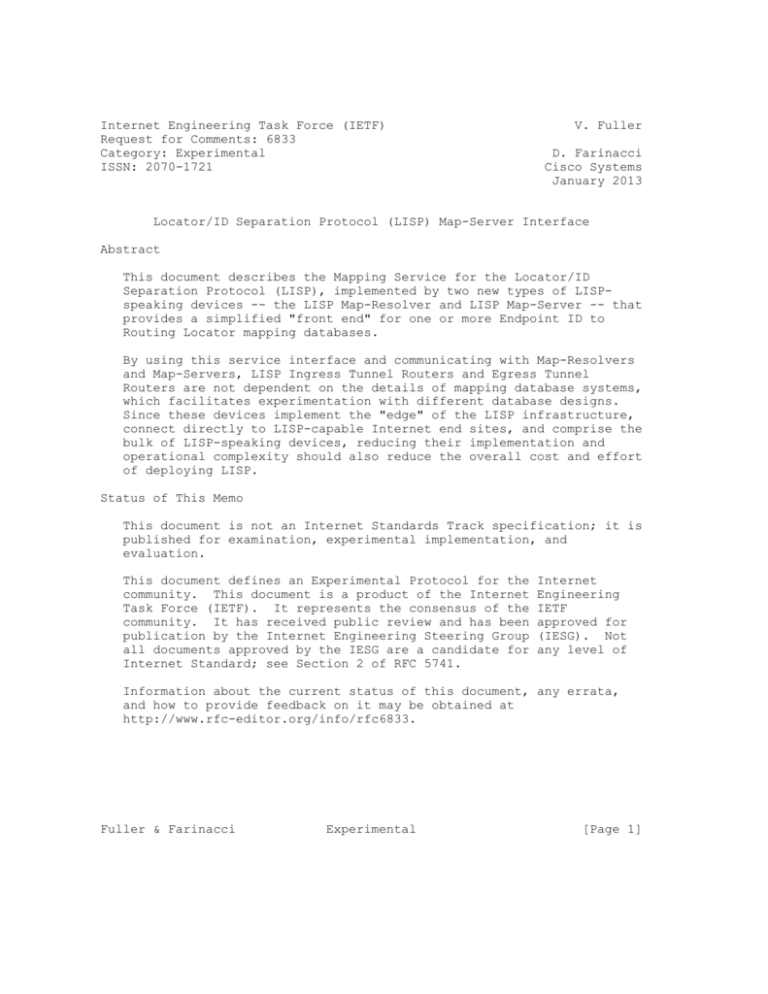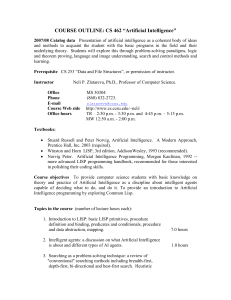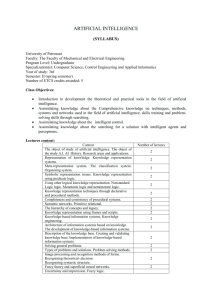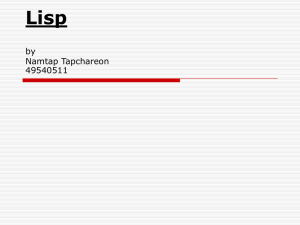
Internet Engineering Task Force (IETF)
Request for Comments: 6833
Category: Experimental
ISSN: 2070-1721
V. Fuller
D. Farinacci
Cisco Systems
January 2013
Locator/ID Separation Protocol (LISP) Map-Server Interface
Abstract
This document describes the Mapping Service for the Locator/ID
Separation Protocol (LISP), implemented by two new types of LISPspeaking devices -- the LISP Map-Resolver and LISP Map-Server -- that
provides a simplified "front end" for one or more Endpoint ID to
Routing Locator mapping databases.
By using this service interface and communicating with Map-Resolvers
and Map-Servers, LISP Ingress Tunnel Routers and Egress Tunnel
Routers are not dependent on the details of mapping database systems,
which facilitates experimentation with different database designs.
Since these devices implement the "edge" of the LISP infrastructure,
connect directly to LISP-capable Internet end sites, and comprise the
bulk of LISP-speaking devices, reducing their implementation and
operational complexity should also reduce the overall cost and effort
of deploying LISP.
Status of This Memo
This document is not an Internet Standards Track specification; it is
published for examination, experimental implementation, and
evaluation.
This document defines an Experimental Protocol for the
community. This document is a product of the Internet
Task Force (IETF). It represents the consensus of the
community. It has received public review and has been
publication by the Internet Engineering Steering Group
all documents approved by the IESG are a candidate for
Internet Standard; see Section 2 of RFC 5741.
Internet
Engineering
IETF
approved for
(IESG). Not
any level of
Information about the current status of this document, any errata,
and how to provide feedback on it may be obtained at
http://www.rfc-editor.org/info/rfc6833.
Fuller & Farinacci
Experimental
[Page 1]
RFC 6833
LISP Map-Server Interface
January 2013
Copyright Notice
Copyright (c) 2013 IETF Trust and the persons identified as the
document authors. All rights reserved.
This document is subject to BCP 78 and the IETF Trust’s Legal
Provisions Relating to IETF Documents
(http://trustee.ietf.org/license-info) in effect on the date of
publication of this document. Please review these documents
carefully, as they describe your rights and restrictions with respect
to this document. Code Components extracted from this document must
include Simplified BSD License text as described in Section 4.e of
the Trust Legal Provisions and are provided without warranty as
described in the Simplified BSD License.
Table of Contents
1.
2.
3.
4.
Introduction ....................................................2
Definition of Terms .............................................3
Basic Overview ..................................................4
Interactions with Other LISP Components .........................5
4.1. ITR EID-to-RLOC Mapping Resolution .........................5
4.2. EID-Prefix Configuration and ETR Registration ..............6
4.3. Map-Server Processing ......................................8
4.4. Map-Resolver Processing ....................................9
4.4.1. Anycast Map-Resolver Operation .....................10
5. Open Issues and Considerations .................................10
6. Security Considerations ........................................11
7. References .....................................................12
7.1. Normative References ......................................12
7.2. Informative References ....................................12
Appendix A. Acknowledgments .......................................13
1.
Introduction
The Locator/ID Separation Protocol [RFC6830] specifies an
architecture and mechanism for replacing the addresses currently used
by IP with two separate name spaces: Endpoint IDs (EIDs), used within
sites; and Routing Locators (RLOCs), used on the transit networks
that make up the Internet infrastructure. To achieve this
separation, LISP defines protocol mechanisms for mapping from EIDs to
RLOCs. In addition, LISP assumes the existence of a database to
store and propagate those mappings globally. Several such databases
have been proposed; among them are the Content distribution Overlay
Network Service for LISP (LISP-CONS) [LISP-CONS], LISP-NERD
(a Not-so-novel EID-to-RLOC Database) [RFC6837], and LISP Alternative
Logical Topology (LISP+ALT) [RFC6836].
Fuller & Farinacci
Experimental
[Page 2]
RFC 6833
LISP Map-Server Interface
January 2013
The LISP Mapping Service defines two new types of LISP-speaking
devices: the Map-Resolver, which accepts Map-Requests from an Ingress
Tunnel Router (ITR) and "resolves" the EID-to-RLOC mapping using a
mapping database; and the Map-Server, which learns authoritative
EID-to-RLOC mappings from an Egress Tunnel Router (ETR) and publishes
them in a database.
Conceptually, LISP Map-Servers share some of the same basic
configuration and maintenance properties as Domain Name System (DNS)
[RFC1035] servers; likewise, Map-Resolvers are conceptually similar
to DNS caching resolvers. With this in mind, this specification
borrows familiar terminology (resolver and server) from the DNS
specifications.
Note that while this document assumes a LISP+ALT database mapping
infrastructure to illustrate certain aspects of Map-Server and
Map-Resolver operation, the Mapping Service interface can (and likely
will) be used by ITRs and ETRs to access other mapping database
systems as the LISP infrastructure evolves.
Section 5 of this document notes a number of issues with the
Map-Server and Map-Resolver design that are not yet completely
understood and are subjects of further experimentation.
The LISP Mapping Service is an important component of the LISP
toolset. Issues and concerns about the deployment of LISP for
Internet traffic are discussed in [RFC6830].
2.
Definition of Terms
Map-Server:
A network infrastructure component that learns of
EID-Prefix mapping entries from an ETR, via the registration
mechanism described below, or some other authoritative source if
one exists. A Map-Server publishes these EID-Prefixes in a
mapping database.
Map-Resolver:
A network infrastructure component that accepts LISP
Encapsulated Map-Requests, typically from an ITR, and determines
whether or not the destination IP address is part of the EID
namespace; if it is not, a Negative Map-Reply is returned.
Otherwise, the Map-Resolver finds the appropriate EID-to-RLOC
mapping by consulting a mapping database system.
Fuller & Farinacci
Experimental
[Page 3]
RFC 6833
LISP Map-Server Interface
January 2013
Encapsulated Map-Request:
A LISP Map-Request carried within an
Encapsulated Control Message, which has an additional LISP header
prepended. Sent to UDP destination port 4342. The "outer"
addresses are globally routable IP addresses, also known as RLOCs.
Used by an ITR when sending to a Map-Resolver and by a Map-Server
when forwarding a Map-Request to an ETR.
Negative Map-Reply:
A LISP Map-Reply that contains an empty
Locator-Set. Returned in response to a Map-Request if the
destination EID does not exist in the mapping database.
Typically, this means that the "EID" being requested is an IP
address connected to a non-LISP site.
Map-Register message:
A LISP message sent by an ETR to a Map-Server
to register its associated EID-Prefixes. In addition to the set
of EID-Prefixes to register, the message includes one or more
RLOCs to be used by the Map-Server when forwarding Map-Requests
(re-formatted as Encapsulated Map-Requests) received through the
database mapping system. An ETR may request that the Map-Server
answer Map-Requests on its behalf by setting the "proxy Map-Reply"
flag (P-bit) in the message.
Map-Notify message:
A LISP message sent by a Map-Server to an ETR
to confirm that a Map-Register has been received and processed.
An ETR requests that a Map-Notify be returned by setting the
"want-map-notify" flag (M-bit) in the Map-Register message.
Unlike a Map-Reply, a Map-Notify uses UDP port 4342 for both
source and destination.
For definitions of other terms -- notably Map-Request, Map-Reply,
Ingress Tunnel Router (ITR), and Egress Tunnel Router (ETR) -- please
consult the LISP specification [RFC6830].
3.
Basic Overview
A Map-Server is a device that publishes EID-Prefixes in a LISP
mapping database on behalf of a set of ETRs. When it receives a Map
Request (typically from an ITR), it consults the mapping database to
find an ETR that can answer with the set of RLOCs for an EID-Prefix.
To publish its EID-Prefixes, an ETR periodically sends Map-Register
messages to the Map-Server. A Map-Register message contains a list
of EID-Prefixes plus a set of RLOCs that can be used to reach the ETR
when a Map-Server needs to forward a Map-Request to it.
Fuller & Farinacci
Experimental
[Page 4]
RFC 6833
LISP Map-Server Interface
January 2013
When LISP+ALT is used as the mapping database, a Map-Server connects
to the ALT network and acts as a "last-hop" ALT-Router. Intermediate
ALT-Routers forward Map-Requests to the Map-Server that advertises a
particular EID-Prefix, and the Map-Server forwards them to the owning
ETR, which responds with Map-Reply messages.
A Map-Resolver receives Encapsulated Map-Requests from its client
ITRs and uses a mapping database system to find the appropriate ETR
to answer those requests. On a LISP+ALT network, a Map-Resolver acts
as a "first-hop" ALT-Router. It has Generic Routing Encapsulation
(GRE) tunnels configured to other ALT-Routers and uses BGP to learn
paths to ETRs for different prefixes in the LISP+ALT database. The
Map-Resolver uses this path information to forward Map-Requests over
the ALT to the correct ETRs.
Note that while it is conceivable that a Map-Resolver could cache
responses to improve performance, issues surrounding cache management
will need to be resolved so that doing so will be reliable and
practical. As initially deployed, Map-Resolvers will operate only in
a non-caching mode, decapsulating and forwarding Encapsulated Map
Requests received from ITRs. Any specification of caching
functionality is left for future work.
Note that a single device can implement the functions of both a
Map-Server and a Map-Resolver, and in many cases the functions will
be co-located in that way.
Detailed descriptions of the LISP packet types referenced by this
document may be found in [RFC6830].
4.
Interactions with Other LISP Components
4.1.
ITR EID-to-RLOC Mapping Resolution
An ITR is configured with one or more Map-Resolver addresses. These
addresses are "Locators" (or RLOCs) and must be routable on the
underlying core network; they must not need to be resolved through
LISP EID-to-RLOC mapping, as that would introduce a circular
dependency. When using a Map-Resolver, an ITR does not need to
connect to any other database mapping system. In particular, the ITR
need not connect to the LISP+ALT infrastructure or implement the BGP
and GRE protocols that it uses.
An ITR sends an Encapsulated Map-Request to a configured Map-Resolver
when it needs an EID-to-RLOC mapping that is not found in its local
map-cache. Using the Map-Resolver greatly reduces both the
complexity of the ITR implementation and the costs associated with
its operation.
Fuller & Farinacci
Experimental
[Page 5]
RFC 6833
LISP Map-Server Interface
January 2013
In response to an Encapsulated Map-Request, the ITR can expect one of
the following:
o
An immediate Negative Map-Reply (with action code of
"Natively-Forward", 15-minute Time to Live (TTL)) from the
Map-Resolver if the Map-Resolver can determine that the requested
EID does not exist. The ITR saves the EID-Prefix returned in the
Map-Reply in its cache, marks it as non-LISP-capable, and knows
not to attempt LISP encapsulation for destinations matching it.
o
A Negative Map-Reply, with action code of "Natively-Forward", from
a Map-Server that is authoritative for an EID-Prefix that matches
the requested EID but that does not have an actively registered,
more-specific ID-prefix. In this case, the requested EID is said
to match a "hole" in the authoritative EID-Prefix. If the
requested EID matches a more-specific EID-Prefix that has been
delegated by the Map-Server but for which no ETRs are currently
registered, a 1-minute TTL is returned. If the requested EID
matches a non-delegated part of the authoritative EID-Prefix, then
it is not a LISP EID and a 15-minute TTL is returned. See
Section 4.2 for discussion of aggregate EID-Prefixes and details
of Map-Server EID-Prefix matching.
o
A LISP Map-Reply from the ETR that owns the EID-to-RLOC mapping or
possibly from a Map-Server answering on behalf of the ETR. See
Section 4.4 for more details on Map-Resolver message processing.
Note that an ITR may be configured to both use a Map-Resolver and to
participate in a LISP+ALT logical network. In such a situation, the
ITR should send Map-Requests through the ALT network for any
EID-Prefix learned via ALT BGP. Such a configuration is expected to
be very rare, since there is little benefit to using a Map-Resolver
if an ITR is already using LISP+ALT. There would be, for example, no
need for such an ITR to send a Map-Request to a possibly non-existent
EID (and rely on Negative Map-Replies) if it can consult the ALT
database to verify that an EID-Prefix is present before sending that
Map-Request.
4.2.
EID-Prefix Configuration and ETR Registration
An ETR publishes its EID-Prefixes on a Map-Server by sending LISP
Map-Register messages. A Map-Register message includes
authentication data, so prior to sending a Map-Register message, the
ETR and Map-Server must be configured with a shared secret or other
relevant authentication information. A Map-Server’s configuration
must also include a list of the EID-Prefixes for which each ETR is
authoritative. Upon receipt of a Map-Register from an ETR, a
Map-Server accepts only EID-Prefixes that are configured for that
Fuller & Farinacci
Experimental
[Page 6]
RFC 6833
LISP Map-Server Interface
January 2013
ETR. Failure to implement such a check would leave the mapping
system vulnerable to trivial EID-Prefix hijacking attacks. As
developers and operators gain experience with the mapping system,
additional, stronger security measures may be added to the
registration process.
In addition to the set of EID-Prefixes defined for each ETR that may
register, a Map-Server is typically also configured with one or more
aggregate prefixes that define the part of the EID numbering space
assigned to it. When LISP+ALT is the database in use, aggregate
EID-Prefixes are implemented as discard routes and advertised into
ALT BGP. The existence of aggregate EID-Prefixes in a Map-Server’s
database means that it may receive Map Requests for EID-Prefixes that
match an aggregate but do not match a registered prefix; Section 4.3
describes how this is handled.
Map-Register messages are sent periodically from an ETR to a
Map-Server with a suggested interval between messages of one minute.
A Map-Server should time out and remove an ETR’s registration if it
has not received a valid Map-Register message within the past
three minutes. When first contacting a Map-Server after restart or
changes to its EID-to-RLOC database mappings, an ETR may initially
send Map-Register messages at an increased frequency, up to one every
20 seconds. This "quick registration" period is limited to
five minutes in duration.
An ETR may request that a Map-Server explicitly acknowledge receipt
and processing of a Map-Register message by setting the
"want-map-notify" (M-bit) flag. A Map-Server that receives a
Map-Register with this flag set will respond with a Map-Notify
message. Typical use of this flag by an ETR would be to set it for
Map-Register messages sent during the initial "quick registration"
with a Map-Server but then set it only occasionally during
steady-state maintenance of its association with that Map-Server.
Note that the Map-Notify message is sent to UDP destination port
4342, not to the source port specified in the original Map-Register
message.
Note that a one-minute minimum registration interval during
maintenance of an ETR-Map-Server association places a lower bound on
how quickly and how frequently a mapping database entry can be
updated. This may have implications for what sorts of mobility can
be supported directly by the mapping system; shorter registration
intervals or other mechanisms might be needed to support faster
mobility in some cases. For a discussion on one way that faster
mobility may be implemented for individual devices, please see
[LISP-MN].
Fuller & Farinacci
Experimental
[Page 7]
RFC 6833
LISP Map-Server Interface
January 2013
An ETR may also request, by setting the "proxy Map-Reply" flag
(P-bit) in the Map-Register message, that a Map-Server answer
Map-Requests instead of forwarding them to the ETR. See [RFC6830]
for details on how the Map-Server sets certain flags (such as those
indicating whether the message is authoritative and how returned
Locators should be treated) when sending a Map-Reply on behalf of an
ETR. When an ETR requests proxy reply service, it should include all
RLOCs for all ETRs for the EID-Prefix being registered, along with
the routable flag ("R-bit") setting for each RLOC. The Map-Server
includes all of this information in Map-Reply messages that it sends
on behalf of the ETR. This differs from a non-proxy registration,
since the latter need only provide one or more RLOCs for a Map-Server
to use for forwarding Map-Requests; the registration information is
not used in Map-Replies, so it being incomplete is not incorrect.
An ETR that uses a Map-Server to publish its EID-to-RLOC mappings
does not need to participate further in the mapping database
protocol(s). When using a LISP+ALT mapping database, for example,
this means that the ETR does not need to implement GRE or BGP, which
greatly simplifies its configuration and reduces its cost of
operation.
Note that use of a Map-Server does not preclude an ETR from also
connecting to the mapping database (i.e., it could also connect to
the LISP+ALT network), but doing so doesn’t seem particularly useful,
as the whole purpose of using a Map-Server is to avoid the complexity
of the mapping database protocols.
4.3.
Map-Server Processing
Once a Map-Server has EID-Prefixes registered by its client ETRs, it
can accept and process Map-Requests for them.
In response to a Map-Request (received over the ALT if LISP+ALT is in
use), the Map-Server first checks to see if the destination EID
matches a configured EID-Prefix. If there is no match, the
Map-Server returns a Negative Map-Reply with action code
"Natively-Forward" and a 15-minute TTL. This may occur if a Map
Request is received for a configured aggregate EID-Prefix for which
no more-specific EID-Prefix exists; it indicates the presence of a
non-LISP "hole" in the aggregate EID-Prefix.
Next, the Map-Server checks to see if any ETRs have registered the
matching EID-Prefix. If none are found, then the Map-Server returns
a Negative Map-Reply with action code "Natively-Forward" and a
1-minute TTL.
Fuller & Farinacci
Experimental
[Page 8]
RFC 6833
LISP Map-Server Interface
January 2013
If any of the registered ETRs for the EID-Prefix have requested proxy
reply service, then the Map-Server answers the request instead of
forwarding it. It returns a Map-Reply with the EID-Prefix, RLOCs,
and other information learned through the registration process.
If none of the ETRs have requested proxy reply service, then the
Map-Server re-encapsulates and forwards the resulting Encapsulated
Map-Request to one of the registered ETRs. It does not otherwise
alter the Map-Request, so any Map-Reply sent by the ETR is returned
to the RLOC in the Map-Request, not to the Map-Server. Unless also
acting as a Map-Resolver, a Map-Server should never receive
Map-Replies; any such messages should be discarded without response,
perhaps accompanied by the logging of a diagnostic message if the
rate of Map-Replies is suggestive of malicious traffic.
4.4.
Map-Resolver Processing
Upon receipt of an Encapsulated Map-Request, a Map-Resolver
decapsulates the enclosed message and then searches for the requested
EID in its local database of mapping entries (statically configured
or learned from associated ETRs if the Map-Resolver is also a
Map-Server offering proxy reply service). If it finds a matching
entry, it returns a LISP Map-Reply with the known mapping.
If the Map-Resolver does not have the mapping entry and if it can
determine that the EID is not in the mapping database (for example,
if LISP+ALT is used, the Map-Resolver will have an ALT forwarding
table that covers the full EID space), it immediately returns a
negative LISP Map-Reply, with action code "Natively-Forward" and a
15-minute TTL. To minimize the number of negative cache entries
needed by an ITR, the Map-Resolver should return the least-specific
prefix that both matches the original query and does not match any
EID-Prefix known to exist in the LISP-capable infrastructure.
If the Map-Resolver does not have sufficient information to know
whether the EID exists, it needs to forward the Map-Request to
another device that has more information about the EID being
requested. To do this, it forwards the unencapsulated Map-Request,
with the original ITR RLOC as the source, to the mapping database
system. Using LISP+ALT, the Map-Resolver is connected to the ALT
network and sends the Map-Request to the next ALT hop learned from
its ALT BGP neighbors. The Map-Resolver does not send any response
to the ITR; since the source RLOC is that of the ITR, the ETR or
Map-Server that receives the Map-Request over the ALT and responds
will do so directly to the ITR.
Fuller & Farinacci
Experimental
[Page 9]
RFC 6833
4.4.1.
LISP Map-Server Interface
January 2013
Anycast Map-Resolver Operation
A Map-Resolver can be set up to use "anycast", where the same address
is assigned to multiple Map-Resolvers and is propagated through IGP
routing, to facilitate the use of a topologically close Map-Resolver
by each ITR.
Note that Map-Server associations with ETRs should not use anycast
addresses, as registrations need to be established between an ETR and
a specific set of Map-Servers, each identified by a specific
registration association.
5.
Open Issues and Considerations
There are a number of issues with the Map-Server and Map-Resolver
design that are not yet completely understood. Among these are:
o
Constants, such as those used for Map-Register frequency,
retransmission timeouts, retransmission limits, Negative Map-Reply
TTLs, et al. are subject to further refinement as more experience
with prototype deployment is gained.
o
Convergence time when an EID-to-RLOC mapping changes, and
mechanisms for detecting and refreshing or removing stale, cached
information.
o
Deployability and complexity tradeoffs of implementing stronger
security measures in both EID-Prefix registration and Map-Request/
Map-Reply processing.
o
Requirements for additional state in the registration process
between Map-Servers and ETRs.
A discussion of other issues surrounding LISP deployment may also be
found in Section 15 of [RFC6830].
The authors expect that experimentation on the LISP pilot network
will help answer open questions surrounding these and other issues.
Fuller & Farinacci
Experimental
[Page 10]
RFC 6833
6.
LISP Map-Server Interface
January 2013
Security Considerations
The 2-way LISP header nonce exchange documented in [RFC6830] can be
used to avoid ITR spoofing attacks.
To publish an authoritative EID-to-RLOC mapping with a Map-Server, an
ETR includes authentication data that is a hash of the message using
a pair-wise shared key. An implementation must support use of
HMAC-SHA-1-96 [RFC2104] and should support use of HMAC-SHA-256-128
[RFC6234] (SHA-256 truncated to 128 bits).
During experimental and prototype deployment, all authentication key
configuration will be manual. Should LISP and its components be
considered for IETF standardization, further work will be required to
follow the BCP 107 [RFC4107] recommendations on automated key
management.
As noted in Section 4.2, a Map-Server should verify that all
EID-Prefixes registered by an ETR match the configuration stored on
the Map-Server.
The currently defined authentication mechanism for Map-Register
messages does not provide protection against "replay" attacks by a
"man-in-the-middle". Additional work is needed in this area.
[LISP-SEC] defines a proposed mechanism for providing origin
authentication, integrity, anti-replay protection, and prevention of
man-in-the-middle and "overclaiming" attacks on the Map-Request/
Map-Reply exchange. Work is ongoing on this and other proposals for
resolving these open security issues.
While beyond the scope of securing an individual Map-Server or
Map-Resolver, it should be noted that a BGP-based LISP+ALT network
(if ALT is used as the mapping database infrastructure) can take
advantage of standards work on adding security to BGP.
Fuller & Farinacci
Experimental
[Page 11]
RFC 6833
7.
LISP Map-Server Interface
January 2013
References
7.1.
Normative References
[RFC1035]
Mockapetris, P., "Domain names - implementation and
specification", STD 13, RFC 1035, November 1987.
[RFC2104]
Krawczyk, H., Bellare, M., and R. Canetti, "HMAC: KeyedHashing for Message Authentication", RFC 2104,
February 1997.
[RFC6234]
Eastlake, D. and T. Hansen, "US Secure Hash Algorithms
(SHA and SHA-based HMAC and HKDF)", RFC 6234, May 2011.
[RFC6830]
Farinacci, D., Fuller, V., Meyer, D., and D. Lewis, "The
Locator/ID Separation Protocol (LISP)", RFC 6830,
January 2013.
[RFC6836]
Farinacci, D., Fuller, V., Meyer, D., and D. Lewis,
"Locator/ID Separation Protocol Alternative Logical
Topology (LISP+ALT)", RFC 6836, January 2013.
7.2.
Informative References
[LISP-CONS]
Brim, S., Chiappa, N., Farinacci, D., Fuller, V., Lewis,
D., and D. Meyer, "LISP-CONS: A Content distribution
Overlay Network Service for LISP", Work in Progress,
April 2008.
[LISP-MN]
Farinacci, D., Lewis, D., Meyer, D., and C. White, "LISP
Mobile Node", Work in Progress, October 2012.
[LISP-SEC]
Maino, F., Ermagan, V., Cabellos, A., Saucez, D., and O.
Bonaventure, "LISP-Security (LISP-SEC)", Work
in Progress, October 2012.
[RFC4107]
Bellovin, S. and R. Housley, "Guidelines for
Cryptographic Key Management", BCP 107, RFC 4107,
June 2005.
[RFC6837]
Lear, E., "NERD: A Not-so-novel Endpoint ID (EID) to
Routing Locator (RLOC) Database", RFC 6837,
January 2013.
Fuller & Farinacci
Experimental
[Page 12]
RFC 6833
Appendix A.
LISP Map-Server Interface
January 2013
Acknowledgments
The authors would like to thank Gregg Schudel, Darrel Lewis, John
Zwiebel, Andrew Partan, Dave Meyer, Isidor Kouvelas, Jesper Skriver,
Fabio Maino, and members of the lisp@ietf.org mailing list for their
feedback and helpful suggestions.
Special thanks are due to Noel Chiappa for his extensive work on
caching with LISP-CONS, some of which may be used by Map-Resolvers.
Authors’ Addresses
Vince Fuller
EMail: vaf@vaf.net
Dino Farinacci
Cisco Systems
Tasman Drive
San Jose, CA 95134
USA
EMail: farinacci@gmail.com
Fuller & Farinacci
Experimental
[Page 13]








